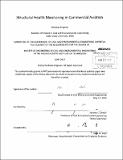Structural health monitoring in commercial aviation
Author(s)
Brigman, Nicholas (Nicholas Allen)
DownloadFull printable version (8.945Mb)
Other Contributors
Massachusetts Institute of Technology. Dept. of Civil and Environmental Engineering.
Advisor
Jerome J. Connor.
Terms of use
Metadata
Show full item recordAbstract
The number of aging commercial aircraft in service is steadily increasing as airlines continue to extend the life of their aircraft. Aging aircraft are more susceptible to fatigue and corrosion and require more frequent and intensive inspections and maintenance, which is a financial drain on operators. One way to improve the economics and safety of commercial aircraft is through implementation of a structural health monitoring (SHM) system. An ideal SHM would be able to give be capable of indicating damage type, location, severity, and estimate the remaining life of the structure while the structure is in use. This paper is an overview of how SHM can be applied in commercial aviation including discussion of requirements, implementation, challenges, and introducing several possible SHM systems. The SHM systems introduced in this paper are: vibration based monitoring, fiber optic sensors, and high frequency wave propagation techniques including acoustic emission, ultrasonic, Lamb waves, piezoelectric and MEMS actuator/sensors. The limitations and challenges inhibiting introduction of SHM to industry and recommendations for the future are also discussed.
Description
Thesis (M. Eng.)--Massachusetts Institute of Technology, Dept. of Civil and Environmental Engineering, 2012. Cataloged from PDF version of thesis. Includes bibliographical references (p. 87-90).
Date issued
2012Department
Massachusetts Institute of Technology. Department of Civil and Environmental EngineeringPublisher
Massachusetts Institute of Technology
Keywords
Civil and Environmental Engineering.